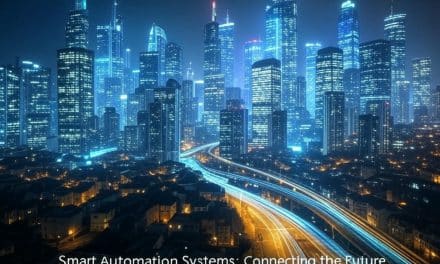Automated systems transform lives—imagine setups that adjust your home lights without effort. They optimize office energy, streamline factories, and simplify life for business leaders, tech managers, and users. This guide unveils intelligent systems across homes, businesses, and beyond.
From IoT gadgets to industrial controls, we’ll explore core concepts, cutting-edge tech, and real-world uses. Whether you seek efficiency, innovation, or a smarter space, these systems bridge ideas and action. Ready to dive in—tech, ethics, and more? Let’s unlock their potential together!
Intelligent systems aren’t just tech—they’re revolutionary, transforming how we live, work, and thrive. This beginner-friendly guide covers setups for homes, offices, factories, and cities. It’s ideal for business leaders seeking efficiency, tech managers planning upgrades, or users wanting smarter spaces.
At their core, smart tech uses sensors and IoT to make environments responsive and efficient. Think lights dimming when you leave, machines predicting maintenance, or cities managing traffic—all driven by automated systems. We’ll start with IoT connections (0.1), the tech backbone (0.2), and human ethics (0.3). Then, we’ll explore strategy and economics (0.4), emerging tech (0.5), and global perspectives (0.6). It’s all connected—from your thermostat to factory floors. See why smart automation systems matter and how they shape our future—clear, engaging, no jargon. Ready? Let’s go!
Smart Automation Systems Essentials
0.1: Foundations and Evolution of Smart Automation Systems
Automated systems start with core concepts—simple ideas powering complex setups. It’s devices connecting, like your phone to a thermostat, working seamlessly. Sensors detect a dark room, or schedules manage lights, forming their foundation.
These basics are easy to grasp, even for tech leaders. They link homes, offices, and factories, boosting efficiency. Curious about smart automation systems’ roots? Check 0.1. It’s the starting point for understanding modern systems.
0.2: Technical Infrastructure and Implementation for Smart Automation Systems
These systems need a backbone—that’s their technical infrastructure. Picture wires, Wi-Fi, or satellites linking devices into a network. It lets your smart doorbell alert your phone or a factory line run smoothly, all via smart tech.
For beginners, it’s like plumbing—simple signals flowing. But it’s robust for big setups, like skyscrapers or warehouses (2.0). Want to know how smart automation systems are built? See 0.2. It’s not just machines—it’s human, too.
0.3: Human and Ethical Considerations for Smart Automation Systems
Automated systems aren’t cold tech—they’re deeply human. Your coffee maker wakes with you, or a factory keeps workers safe, thanks to these systems. But questions arise: Who controls them? Do they benefit everyone?
Ethics balance efficiency and fairness. Imagine a smart city—great for traffic, but privacy? It’s a conversation for leaders, techies, and users (1.0). Explore 0.3 to see their impact. That leads to their business value.
0.4: Strategic and Economic Aspects of Smart Automation Systems
Why use automated systems? They’re strategic and save money. Businesses cut costs—lights off when empty—while homes save on bills. It’s simple: these systems deliver ROI, from a smart plug to a corporate setup (2.0).
For decision-makers, it’s a no-brainer—invest now, thrive later. Curious about the numbers or planning tips for smart automation systems? Check 0.4. New tech keeps pushing these systems forward.
0.5: Emerging Technologies Integration for Smart Automation Systems
The future’s here—these systems grow smarter with AI, robots, and more. Imagine a fridge ordering groceries or a factory predicting breakdowns, all via smart tech. These innovations make them sharper.
It’s exciting for everyone: easier living, better work (3.0). Curious about their future? See 0.5. But they adapt differently worldwide.
0.6: Global Perspectives on Smart Automation Systems
Automated systems vary globally. One city syncs traffic lights; another powers homes with solar, using these systems. Culture, budget, and climate shape them—Japan’s robots vs. rural grids.
It’s about adapting locally (4.0). See how the world uses smart automation systems in 0.6. Explore deeper or stay broad!
Conclusion
Automated systems open a connected, efficient future—and this guide’s just the start. We’ve covered essentials: core concepts (0.1), tech (0.2), human ethics (0.3), strategy (0.4), emerging tech (0.5), and global views (0.6). They connect homes, offices, and factories, driving innovation for leaders and users.
For decision-makers, smart automation systems simplify strategy—start with a smart plug at home (1.0) or plan office upgrades (2.0). Dive into IoT for smart automation systems (0.1.3) or industry insights (3.0). These systems shift how we live—jump in, start small, or dream big. Smart automation systems’ future is here—grab it!
Smart Automation Systems Questions
What are smart automation systems, anyway? They use tech—like sensors and apps—to run things automatically. Think lights off when you leave or factories speeding up, all via smart tech. They ease life across homes and businesses (0.1).
How do smart automation systems work? Devices connect via networks—Wi-Fi, wires, etc. A sensor detects motion, telling a light to act, thanks to smart automation systems. It’s a solid tech backbone (0.2)—smart, simple design!
Do smart automation systems save money? Yes—big time! Businesses cut energy with auto-shutoffs, homes save with thermostats, all using smart automation systems. It’s a win for wallets and the planet (0.4).
What’s the future for smart automation systems? Picture AI running fridges or robots fixing factories, all with smart automation systems. New tech makes them sharper daily (0.5)—the future’s now!
Explore More
Want more? Check these out: 0.1.3: Internet of Things in Smart Environments dives deeper into smart automation systems’ tech. 1.1: Home Automation Foundations offers basics for homes using smart automation systems. These build on essentials—jump in!



